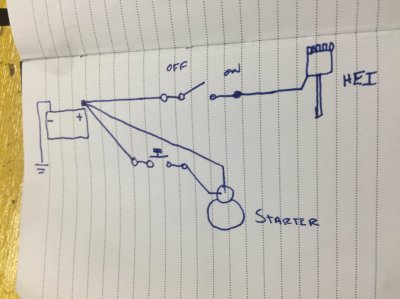I did that once - and rigged it electrically pretty much just as you show in your dwg. Do try to get the connection for battery negative cable as close as possible to the starter and use a big heavy fastener. Like maybe one of the bolt holes for the motor mount bracket - or one of those ground strap holes on the back of the head.
A couple of things that I learned from doing that - and they both have to do with the fact that you
will want to bring the revs up. When you rev it up past idle:
1. It is going to be
really loud. I am assuming the exhaust system will not be installed. I did it way out in the country so it didn't matter so much, but if I had done it in a residential setting...the law would have probably gotten involved.
2. I don't know how you plan to support the engine, but make sure it is rigidly mounted. At first I was just going to hang a 350 from a chain fall strapped to the garage joists. Then I started thinking about the torsional forces involved and what the engine would do when it was revved up. I had a scrap frame laying around - with no front clip - and decided to take the extra time to set the motor on the frame mounts. Turns out it was a good thing I did that. When the test run was over, I was curious to see what could've happened had it been just suspended from the falls. We released the mounts, lifted the engine and fired it up again. It twisted a bit when first fired up and then settled down when allowed to idle. But quickly increasing the rpm over say 2K was a different story. It wasn't a Chinese fire drill or anything, but that sucker really wanted to get off that chainfall. It looked like a horse being broken; it twisted in all planes but especially on it's rotational axis.
Bottom line; between the engine swinging dangerously and the unmuffled exhaust it would not made for a comfortable test run. It would have been a rush job and if anything were wrong it might have been missed.
Also, I don't read anything in your post that would indicate that a cam break-in is part of the plan. But even still, you might want to run a length of tubing or 1/8" pipe away from the engine and install a temporary oil pressure gauge. That will give you peace of mind that your oil pump is putting out sufficient volume and pressure. Nothing sucks like hearing a knock in a newly built and completely installed engine.
I didn't bother with running a temporary coolant indication. I just pulled the t-stat and used my hands to gauge coolant temp.
Have a fire extinguisher handy. I don't know how you plan to supply the fuel during the test run but keep the container far away from the action and make sure your gas line connections are tight - especially if you are using a remotely situated electric pump. Things can get a little hectic, and the last thing you want is one of your assistants having a Three Stooges type moment and tripping over the fuel line. With the exhaust open to atmosphere and the ignition secondary just temporarily assembled, there are many ways to start a fire.
For example, this:
You must be registered for see images attach
You must be registered for see images attach
You must be registered for see images attach
You must be registered for see images attach
You must be registered for see images attach
turned to this:
You must be registered for see images attach
You must be registered for see images attach
You must be registered for see images attach
in the blink of an eye.
It happened because I had the distributor cap open (and the gas supply to the carb disconnected) while priming the fuel lines. Those mechanical fuel pumps will pick up a suction from the tank and pack the entire system in a heartbeat. I had reached into the cab to crank the engine and was watching through the space between the hood and the cowling. It didn't take even two crankshaft revolutions when all of a sudden there was a strange orange glow coming from the engine compartment. The gas line had sprayed a mist over the manifold. So, with the distributor open and all that fresh engine paint...well you get the picture. By the time I was able to put it out (less than a minute), all that work was down the drain. It was all superficial stuff but it sucked to have to pull and re-finish it.


